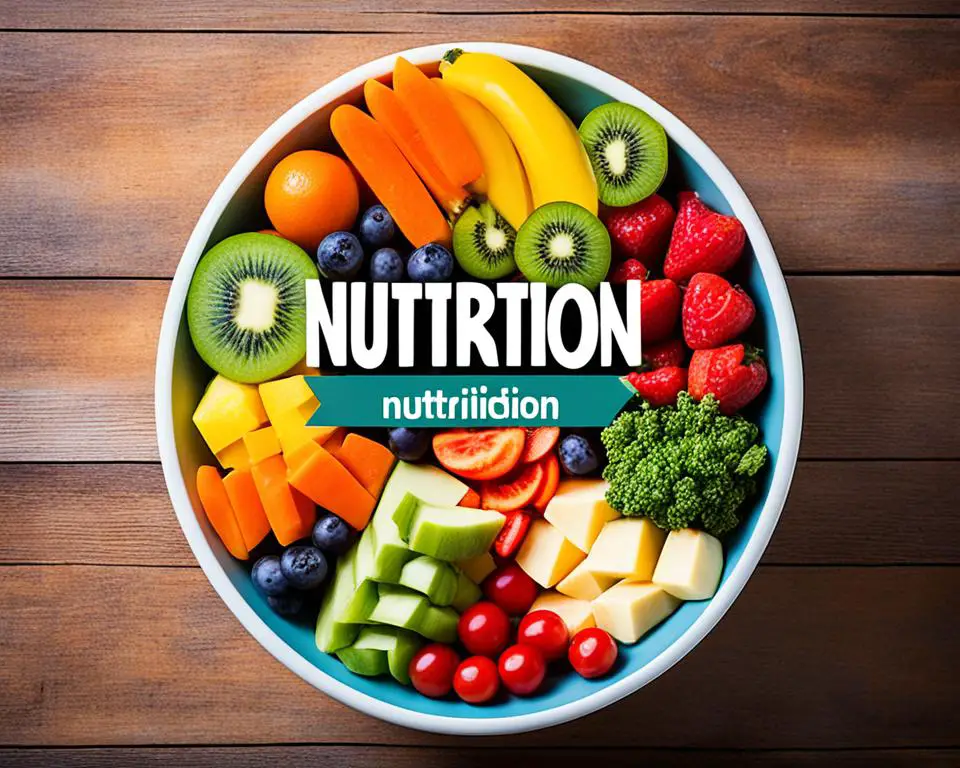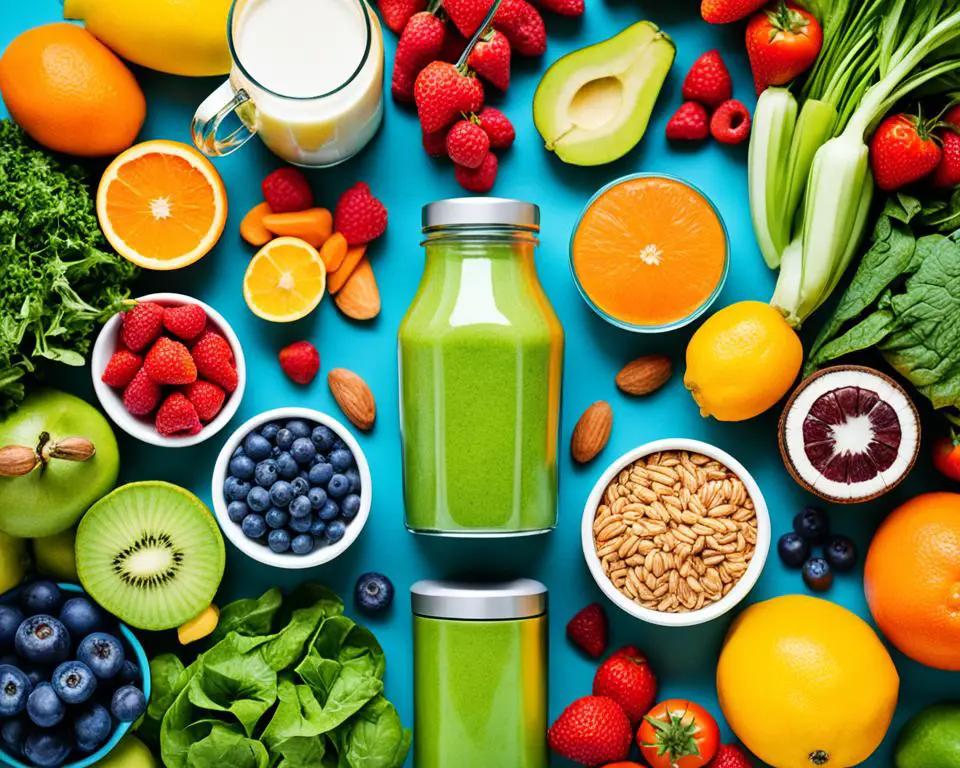Genesis Medical Associates highlights the strong connection between eating well and feeling good. March is a great time to focus on health. It’s called “National Nutrition Month®” by health experts, urging people to eat healthier.
A balanced diet is key. It should include fruits, veggies, whole grains, lean proteins, and healthy fats. These foods help your body and boost your immune system.
During Nutrition Month, there are fun activities like online cooking shows and food drives. These events teach and involve the community. Eating mindfully, like controlling portions and making small changes, is crucial for lasting health. These habits can improve your mood, energy, and how well you perform daily.
Key Takeaways
- City mayors or state governors can declare March as “National Nutrition Month®”.
- 31 nutrition tips can be shared throughout March.
- Virtual cooking demos and nutrition events can engage audiences.
- Encourage families to try a new fruit or vegetable each week.
- Avoiding large portion sizes can help prevent overeating and weight gain.
- Planning meals in advance promotes healthier food choices.
The Importance of Balanced Nutrition
A balanced diet is key for good health, boosting mood, and lowering the risk of chronic diseases like obesity and diabetes. Foods from all groups give the body what it needs to work right. Eating well boosts energy and mood, showing how our food choices affect us.
Benefits for Physical Health
Choosing a balanced diet has many physical health perks. It means getting important vitamins, minerals, and antioxidants from various foods. For example:
- Eating lots of fruits and veggies gives you natural fiber.
- Low-fat or fat-free milk gives you calcium and vitamin D for strong bones.
- Lean meats and poultry offer protein with less fat and calories.
- Whole grains should be half of what you eat in cereals, breads, and pastas.
A healthy diet lowers the risk of heart disease, diabetes, and other serious illnesses. It’s key for preventing chronic diseases and managing health issues.
Mental Health and Well-being
What we eat affects our mental health and well-being. Foods rich in nutrients feed our bodies and minds, keeping us emotionally strong. Not getting enough vitamins A, B, C, E, zinc, iron, and selenium weakens our immune system, making us more likely to get sick.
Good nutrition also helps our brains work better and keeps us in a good mood. Foods like whole grains, fruits, veggies, and lean proteins are crucial for our mental health. They help us focus, remember things, and lower the chance of mental health problems.
Reducing Risk of Chronic Diseases
Staying on a balanced diet is crucial for avoiding chronic diseases. Research shows that diet is linked to four of the top ten causes of death in the U.S., including heart disease and diabetes.
- A diet low in saturated fat and high in fiber from whole grains can lower the risk of type 2 diabetes.
- Fruits, veggies, whole grains, and low-fat dairy keep blood pressure and cholesterol in check, cutting down heart disease risk.
- Eating oily fish weekly can help prevent heart disease thanks to omega-3 fatty acids.
- A diet full of calcium keeps bones strong, and vitamin D helps with calcium absorption and bone health.
By focusing on these health aspects through diet, we get big benefits for our physical and mental health. This supports long-term wellness and helps prevent chronic diseases.
Understanding Portion Control
Controlling how much we eat is key to eating healthy and not eating too much. In our culture, we often eat more than we should. Knowing the right serving sizes and using smart techniques can help us eat better.
Recognizing Serving Sizes
It’s important to know what a standard serving size is for food. For example, a serving of meat is like a deck of cards, and half a cup is a common size for grains. But, in restaurants, we often get much more food than that, which can lead to eating too much.
Using big dishes can make us eat up to 77% more food than if we used smaller bowls. Knowing the right serving sizes helps us eat just what we need and avoid extra calories. The FDA has updated serving sizes to match how we really eat, like increasing ice cream servings from 1/2 cup to 2/3 cup.
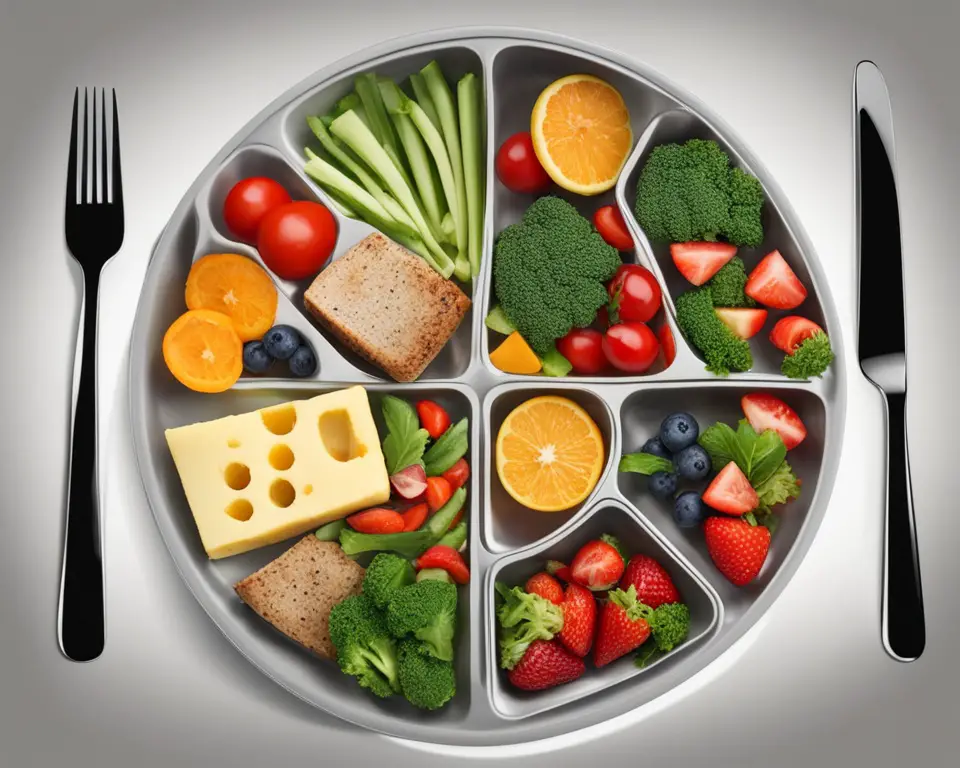
Techniques for Controlling Portions
There are smart ways to control how much we eat. Eating slowly lets our brain catch up with how full we are. Listening to our body’s hunger signals and only eating when we’re really hungry can also help us eat less.
Drinking water before meals is another good trick. It can help us eat less and lose weight. Using smaller containers for snacks can also make us eat less. People eat way more candies from big containers than small ones.
Keeping a food diary helps us pay attention to how much we eat. Tools like the MyPlate Plan and Body Weight Planner give us advice on how many calories we need each day. This helps us control our portions and make healthier choices.
Incorporating More Fruits and Vegetables
Adding more fruits and vegetables to your diet is key for better health. These foods are packed with vitamins, minerals, and fibers that boost your well-being. You can easily add them to your meals with fresh and frozen options.
Fresh vs. Frozen Produce
Fresh and frozen fruits and vegetables both have great benefits. Fresh produce is perfect for those who love the crisp taste of new fruits and veggies. Frozen options, on the other hand, are often frozen at the peak of ripeness, keeping most of their nutrients.
It’s smart to mix both fresh and frozen into your diet for variety and ease. This way, you get the best of both worlds.
Tips for Including Vegetables in Meals
To hit the daily goal, try to eat at least five servings of fruits and vegetables every day. Here are some easy tips:
- Blend them into smoothies: A tasty way to kickstart your day with extra nutrients.
- Add extra vegetables to meals: Hide them in soups, stews, and sauces.
- Snack on fresh produce: Keep pre-cut veggies and fruits handy for a quick snack.
- Experiment with new recipes: Trying new dishes makes eating more vegetables fun.
- Choose colorful options: Different colors mean different nutrients, making your meals both pretty and healthy.
Using visual aids can also help. For example, the MyPlate guide suggests filling half your plate with fruits and vegetables. This can inspire you to stick with a balanced diet.
Avoiding Processed Foods
It’s key to eat less processed food to stay healthy. These foods are full of unhealthy fats, sugars, and salt. In the US and UK, over half of what we eat daily comes from these foods. This leads to more heart disease, weight gain, cancer, and death.
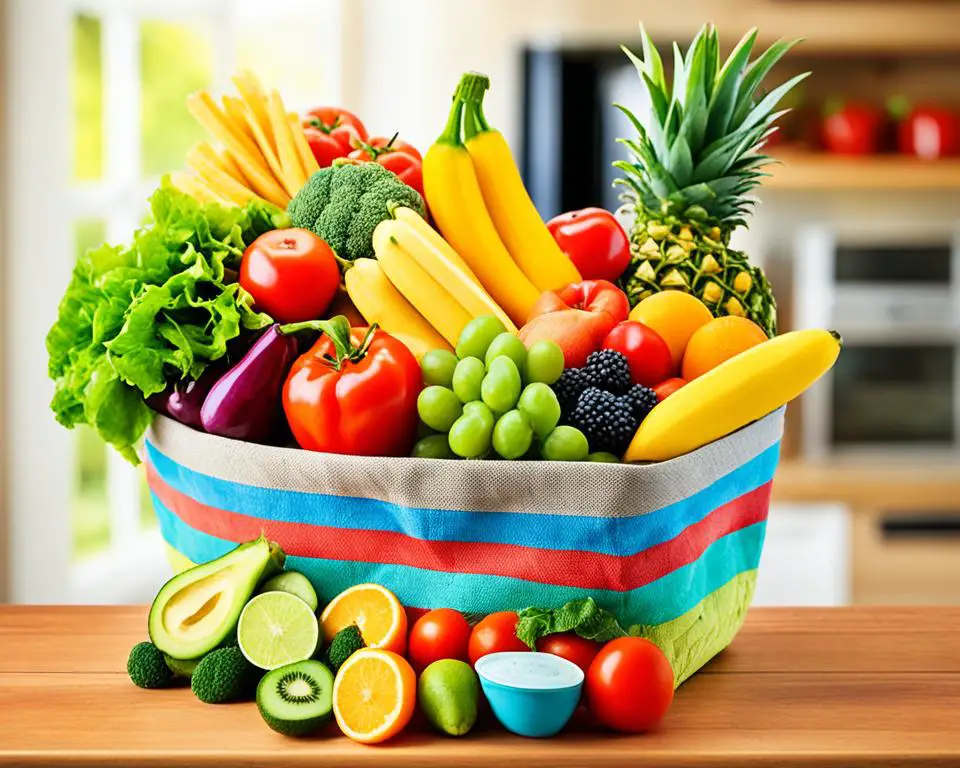
Identifying Processed Foods
First, know what processed foods are. Some examples include:
- Soda
- Packaged snacks
- Breakfast cereals
- Instant noodles
- Fast food
- Processed meats like bacon, sausages, and lunch meat
These foods have additives that are bad for us. Eating more of these foods can up your cancer risk by 12%. It can also make you eat 500 extra calories a day and harm your gut health. This can lead to serious illnesses like heart disease, type 2 diabetes, and obesity.
Healthier Alternatives
For a better diet, pick healthier options. Here are some:
- Fruits and vegetables
- Whole grains instead of refined grains
- Fresh meat instead of processed meats
- Nuts and seeds
- Yogurt
- Spices and herbs as flavor enhancers
Meal prepping helps you eat better and avoid fast foods. Switching to whole grains can boost your nutrient intake and fiber. This can protect you from heart disease, diabetes, and some cancers. Eating a variety of foods in moderation is key to a balanced diet.
| Nutrient Content | High | Low |
|---|---|---|
| Total Fat (per 100g) | More than 17.5g | 3g or less |
| Saturated Fat (per 100g) | More than 5g | 1.5g or less |
| Sugars (per 100g) | More than 22.5g | 5g or less |
| Salt (per 100g) | Over 1.5g (0.6g sodium) | 0.3g or less (0.1g sodium) |
Staying Hydrated

Drinking enough water is key for good health. Our bodies need water to move nutrients, digest food, and keep our brains working right. It’s vital to know how important water is for us.
The Role of Water in the Body
Water helps control body temperature, keeps joints lubricated, and protects tissues. The U.S. National Academies suggest men drink about 15.5 cups of fluids daily. Women should aim for 11.5 cups. Foods also add to our daily fluid intake, making up about 20% of it.
Most people can stay hydrated by drinking water and other fluids as they need to. But, our needs change with exercise, weather, health, and life stages like pregnancy. Athletes need to watch their fluid intake to avoid serious health issues.
Practical Tips for Staying Hydrated
Staying hydrated takes effort and awareness. Here are some tips to help you stay hydrated:
- Carry a reusable water bottle: Having water easy to get to helps you drink more.
- Drink water regularly: Drink water at set times during the day, don’t wait until you’re thirsty.
- Consume water-rich foods: Eat foods with lots of water like fruits and veggies to help with hydration.
Athletes doing hard workouts in the heat might benefit from sports drinks with electrolytes. But, drinking water before exercise is key to avoid dehydration and heart strain.
| Gender | Recommended Daily Fluid Intake |
|---|---|
| Men | 15.5 cups (3.7 liters) |
| Women | 11.5 cups (2.7 liters) |
Your urine’s color can tell you if you’re drinking enough water. Clear or pale urine means you’re hydrated, dark urine means you’re not.
Drinking enough water is crucial for your body’s functions and a healthy life. For more info, check out guidelines from trusted sources like the Mayo Clinic.
Practice Mindful Eating
Making mindful eating a part of your daily life can greatly boost your health. It means eating without distractions like phones or TVs. This way, you can better understand when you’re full, which can stop you from eating too much.

Being more aware of your food choices helps you enjoy smaller meals and feel more satisfied. This approach can lead to losing weight and cutting down on unhealthy eating habits. For example, a study found that mindful eating led to a 4-pound weight loss over 12 weeks.
One big plus of mindful eating is knowing the difference between hunger and emotional eating. This awareness helps you handle emotional eating better, leading to less stress and more control over your eating. Studies show it can be as effective as other diets in helping people with type 2 diabetes eat healthier.
It also helps people with eating disorders like binge eating or bulimia. By choosing healthier foods, like fruits over desserts, you can improve your diet quality. This makes mindful eating a powerful tool for better health.
By adopting mindful eating, you can build a healthier relationship with food. This leads to better health and happiness over time.
Meal Planning and Preparation
Planning your meals ahead and preparing them in advance has many benefits. It makes your weekly routine smoother and helps you eat healthier. It also keeps you away from unhealthy takeout meals.
Benefits of Planning Ahead
A busy schedule often makes people choose quick takeout meals, which can be bad for health. By planning your meals, you can cut down on these unhealthy choices. This approach saves money and time, helps control your weight, and makes your diet more balanced. It also reduces stress from making last-minute meal decisions.
Setting specific days for shopping, cooking, and prepping meals helps you stay on track with your goals. Cooking in bulk and storing food for later lets you enjoy the perks of meal planning, such as:
- Healthier meal choices
- Time and money savings
- Better diet management
- Reduced food waste
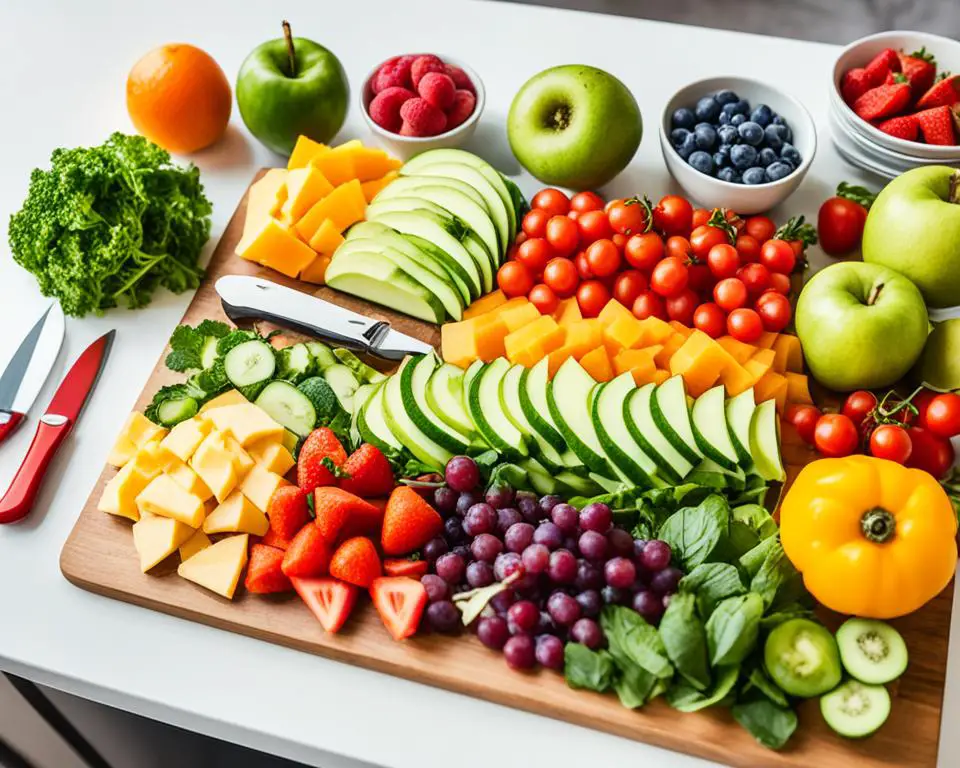
Tips for Home Cooking
Home cooking doesn’t have to be hard. With some tips, making healthy meals can be fun and rewarding. Here are ways to make your meal prep efficient and effective:
- Select Diverse Recipes: Pick recipes that offer variety and include all food groups for a balanced diet.
- Cook in Batches: Cook meals for 2-3 days at once. Dishes like Farro with Confetti Vegetables, Vegetarian Shepherd’s Pie, and Cauliflower Tomato Soup with Indian Spices can be made in bulk and stored.
- Utilize Refrigeration and Freezing: Keeping your prepped items fresh is key. Use labels to track when they were stored and follow storage guidelines to keep flavors and food safe.
- Use a Meal Planning Template: Use a template to organize your recipes and meals. This helps reduce waste and ensures you have a variety of meals. Resources like USDA’s MyPlate Kitchen offer templates and healthy recipes to help you.
By following these tips, healthy meal preparation can become easy and part of your weekly routine. This leads to a healthier and less stressful life.
| Benefits of Meal Planning | Statistics |
|---|---|
| Time Savings | Around 85% of individuals spend less time deciding on meals. |
| Money Savings | Using pantry or freezer items can reduce grocery expenses. |
| Healthier Choices | 60% resort to takeout if there’s no meal plan in place. |
| Reduced Waste | Lack of planned usage leads to wasting around 30% of purchased food. |
Understanding Food Labels
Learning to read food labels is key for a healthy diet. These labels have important info that helps you make better choices at the grocery store. By understanding them, you can keep your daily calorie intake at the recommended 2,000 calories. But remember, everyone’s needs are different.
Key Components to Look For
First, look at the serving size on food labels. It’s important to know that eating more servings means you’ll get more calories and nutrients. The Nutrition Facts label shows the total fat, saturated fat, and added sugars in a product. These are often eaten too much and can lead to health problems like heart disease and high blood pressure.
Also, check for dietary fiber, vitamin D, calcium, iron, and potassium. These are nutrients many people don’t get enough of and need more of for good health.
Comparing Nutritional Information
The Nutrition Facts label has the Daily Value (%DV) to help you compare foods. Foods with 5% DV or less have low nutrients, and those with 20% DV or more have high amounts. This helps you make better choices throughout the day.
If a food has a lot of sodium, you might choose other foods with less sodium. This way, your diet will support your nutritional goals better.
Source Links
- 50 Ideas to Get Involved in National Nutrition Month®
- Genesis Medical Associates, Inc.
- 5 Ways to Celebrate National Nutrition Month® | Tyson Foods
- The Importance of Good Nutrition
- Balanced Diet: What Is It and How to Achieve It
- Health benefits of eating well
- 9 Tips to Measure and Control Portion Sizes
- Food Portions: Choosing Just Enough for You – NIDDK
- Portion Control | Nutrition Education Services Center
- Simple, inexpensive ways to eat more fruit and veggies
- How to Incorporate More Fruits and Vegetables into Your Diet
- How to Eat More Fruit and Vegetables
- What Is Ultra-Processed Food and How Can I Avoid It?
- 10 Easy Tips for Lowering Your Processed Food Intake
- Eating processed foods
- How much water do you need to stay healthy?
- Water, Hydration, and Health | Nutrition.gov
- Staying Hydrated, Staying Healthy
- 6 Ways to Practice Mindful Eating
- Mindful Eating 101 — A Beginner’s Guide
- Mindful Eating
- Meal Prep Guide
- Meal Planning For Beginners (Meal Plan Template Inside!)
- Healthy Meal Planning: Tips for Older Adults
- How to Understand and Use the Nutrition Facts Label
- How To Read Food and Beverage Labels
- Nutrition Facts Label and Your Health


